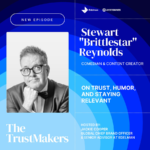Insights from Heather Roestamadji, Senior Manager for the Optimize Product at Claritas, and Simon Whittick, Director of Product Marketing at Anzu
For decades, last-click attribution has been the bedrock of digital marketing measurement. Its simplicity and direct correlation between spend and revenue offered a clear, quantifiable link that resonated with CFOs and CMOs. Yet, as the digital landscape diversifies and consumer journeys become increasingly complex, the industry is grappling with a fundamental question: Is it time to finally retire the last click?
We sat down with Simon Whittick, Director of Product Marketing at Anzu, the intrinsic in-game advertising solution, and Heather Roestamadji, Senior Manager for the Optimize Product from Claritas, a leader in integrated marketing optimization, to explore the shifting paradigms of attribution. Both offer compelling arguments for moving beyond the click, while also providing practical pathways for marketers navigating this evolving terrain.
The Cracks in Last-Click’s Foundation
Simon Whittick of Anzu is unequivocal: last-click attribution needs to be retired. His primary argument centers on the rise of “inherently less clickable” yet highly impactful marketing channels. “Organic content on social won’t go viral when there’s an external link,” Whittick notes, highlighting how platform algorithms prioritize keeping users within their ecosystems. Similarly, search engines increasingly provide answers directly, reducing clicks, and AI chatbots like ChatGPT and Peplexity offer information without users ever leaving the environment. Even established channels like CTV and emerging ones like premium in-game advertising, despite reaching billions and offering significant brand impact, are largely non-clickable environments. “If you ignore these channels,” Whittick warns, “you are significantly kneecapping your acquisition strategy.”
Roestamadji echoed this sentiment, stating that while last-click is simple and offers instant feedback, “clicks show only part of the story.” She emphasizes that “emerging, non-clickable channels—gaming, CTV, podcasts—can strongly influence conversions and purchases. They deserve their share of credit, and measurement solutions that capture their true impact will set the new industry standard.”
Furthermore, Whittick points to the sophistication of modern ad networks and media channel algorithms. These systems are so adept at predicting conversions that they often place clickable ads in front of users who would convert regardless, leading to a lack of causal or incremental impact. This, he argues, can lead to short-term investment decisions that prioritize demand capture over demand creation, ultimately driving up customer acquisition costs and stifling growth.
Beyond the Click: A Spectrum of Solutions
Both Anzu and Claritas advocate for a more holistic approach, leveraging a mix of advanced measurement methodologies.
Claritas emphasizes an “education play” for marketers, illustrating how they balance established models with newer approaches. They report last-click/last-touch attribution and incrementality by default. “Incrementality answers, ‘Is the campaign generating net-new business?'” explains Roestamadji, highlighting how a purchase from a frequent customer might not be incremental, while a new customer’s purchase is. Once marketers grasp this, Claritas layers in multi-touch attribution (MTA) to show how all touchpoints share credit. They cite examples like Good Karma Brands-ESPN Digital and SiriusXM, where combining attribution and lift analysis revealed significant incremental website visits, product line lifts, and purchase increases.
Anzu’s Si Whittick outlines key alternatives:
- View-Through / Multi-Touch Attribution: This gives credit for ad views, not just clicks, and acknowledges upper-funnel channels. Whittick sees this as a good starting point for channel-level optimization, even while acknowledging the potential for non-causal credit. Anzu has validated integrations with major vendors like Adjust, Appsflyer, Kochava, Neustar and Claritas, reporting average conversions 21% below advertiser CPA goals.
- Incremental Lift: This method ensures that media spending genuinely adds to conversions by comparing exposed and control groups. While it requires scale, its focus on proving incremental impact is crucial. Anzu has successfully run an incremental lift test with Claritas for a major financial services brand, proving their incremental impact.
- Media Mix Modelling (MMM): A statistical technique for macro-level, omnichannel optimization of channel investments. While not ideal for individual campaign optimization, it offers a broad view of brand and performance impact.
“Ultimately, different scenarios and advertiser goals will suit different measurement types,” Whittick concludes. “Many brands will likely require a mix of these measurement types.”
Addressing Misconceptions and Capturing Full Value
According to Roestamadji, a common misconception is that “many marketers judge each channel in isolation, relying on that channel’s own ad-server analytics.” The problem, they note, is that “each server overstates its impact because it can’t see overlap or cross-device paths.” Claritas addresses this by measuring all channels in one platform, revealing the true incremental effect of every ad while adjusting for audience overlap and cross-channel interactions.
For non-clickable channels, Roestamadji advises marketers to “work with measurement partners that leverage a robust identity graph.” Cross-device attribution is critical, as a viewer might see an in-game ad on console and convert on another device. Without connecting these events, channels are under-credited, and budgets are misallocated.
The Future is AI-Driven and Gaming-Ready
Both experts look to AI and machine learning as the next frontier in attribution. Whittick envisions a future where “AI models can do analysis on complex and disparate measurement data across the funnel to advise on investment decisions.” He believes the “walls between brand and performance measurement could be broken down,” with AI combining vast datasets from various measurement formats to make smart investment decisions, effectively doing “the work of hundreds if not thousands of data analysts.”
Roestamadji is equally enthusiastic, highlighting two upcoming advances: an AI-driven “What-If” Simulator for predictive media planning, and the extension of their incrementality measurement to gaming and the metaverse.
For gaming specifically, Whittick notes that it has been a “nascent channel” in terms of measurement but is now “getting to a point where you can compare gaming apples-to-apples to other channels.” He’s excited to see more evidence of both the upper and lower funnel impact of gaming in the next 12 months.
Practical Steps for Marketers
For marketers still heavily relying on last-click, both offer actionable advice:
- Roestamadji suggests a practical first step: “Run a small lift test in one market or on one channel while keeping everything else constant. When the test ends, compare the results side-by-side with last-click.”
- Whittick recommends moving from last-click to view-through/multi-touch attribution as a minimum starting point for channel-level optimization. He also advises running an incremental lift study on your largest channel to build a case for more incremental forms of measurement, eventually considering media mix modelling for macro-level investment decisions.
In essence, the message from both Claritas and Anzu is clear: the era of singular, click-based attribution is waning. A sophisticated, multi-faceted approach, leveraging the power of incrementality, multi-touch models, and the burgeoning capabilities of AI, is not just a future possibility but a present necessity for marketers seeking true impact and sustainable growth in a complex, non-clickable world.











